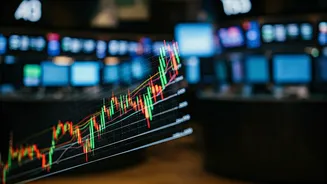Trade Deal Dynamics
An India-US trade agreement carries significant implications for the Indian stock market. Economic analysts and market observers are keenly watching the progress
of negotiations, anticipating that a successful deal could act as a catalyst for market growth. Agreements of this nature typically lead to enhanced trade volumes, investment flows, and technology transfers. These elements can significantly influence economic growth and improve market sentiment, potentially causing a rise in stock valuations. Key sectors that could experience gains include those directly involved in trade with the U.S., such as manufacturing, pharmaceuticals, and technology services. However, market reactions are intricate and can vary, with outcomes depending on the specific terms of the deal and the general economic backdrop.
Market Trend Reversal
The possibility of a trend reversal in the Indian stock market is a central focus. A trade agreement with the U.S., a major global economy, has the ability to shift market direction by influencing investor confidence and encouraging greater investments. This could lead to an upward trend, especially if the deal opens up new markets for Indian goods and services, leading to revenue and profit growth. Investors often interpret trade agreements as signals of stability and opportunities for expansion. The anticipation and subsequent implementation of the agreement could result in an increase in stock prices, driving up overall market performance. The degree to which a reversal occurs depends on various factors, including the breadth of the deal, its implementation timeline, and the prevailing global economic environment.
Sector-Specific Impacts
Specific sectors of the Indian economy are likely to be more profoundly affected by a trade deal with the U.S. Industries that are heavily reliant on exports to the U.S. or stand to benefit from increased U.S. investment are expected to show the most immediate impacts. For instance, the pharmaceutical industry could experience growth through easier access to the U.S. market and regulatory streamlining. The technology and IT sectors may also gain, with more opportunities for collaboration and expansion. Furthermore, sectors such as infrastructure and renewable energy might see an uptick in investment, reflecting strategic areas of cooperation. Analyzing sector-specific impacts is crucial for investors, helping them to make informed decisions and better understand the potential for growth across various segments.
Investor Sentiment Shifts
Investor sentiment is significantly shaped by trade agreements. The signing of a trade deal with the U.S. could boost confidence in the Indian market, attracting both domestic and foreign investment. This increased confidence can lead to a shift from cautious investment strategies to more aggressive ones, potentially resulting in higher trading volumes and asset valuations. Furthermore, the certainty offered by a formal trade agreement could reduce risk perceptions, leading investors to re-evaluate their portfolio allocations. The overall impact on market sentiment would be multifaceted, depending on the details of the agreement, the global economic situation, and how effectively the deal is communicated to investors. Positive sentiment usually fosters a favorable atmosphere for market growth, creating a dynamic environment for both existing and new investors.
Challenges and Risks
Despite the optimism surrounding a potential India-US trade deal, it's essential to recognize the challenges and risks involved. Global economic conditions, shifts in geopolitical dynamics, and unforeseen events could all impact the deal's effectiveness and market response. Competition from other global economies, changes in trade policies, and internal economic challenges within India could also affect the positive impacts of the agreement. Trade negotiations themselves can be complex and prolonged, causing market uncertainty and volatility. Investors should therefore consider the potential for unforeseen issues and adjust their investment strategies accordingly. Diversifying portfolios and staying informed about the latest developments and geopolitical risks are critical to navigating market fluctuations and challenges.
















